 Colca Canyon, Peru. Original photo by Peru For Less.
Colca Canyon, Peru. Original photo by Peru For Less.Journey to Colca Canyon, the second deepest canyon in the world, from the enchanting city of Arequipa in southern Peru. Walk from the condor observatory down to the lower parts of the canyon, visit the terraces that once sustained empires, and soak in natural hot springs. In other words, unplug from what we call civilization and let yourself be awed by the beauty in Colca Canyon. All this and more awaits on a trip to Colca Canyon.
Colca Canyon, or Canon del Colca in Spanish, ranks high among the most stunning natural landscapes in Peru. The terrain and elevations vary dramatically, and chains of mountains guard Andean towns within the valley. Endless rows of hillside terraces and colcas, or storehouses, dot Colca Canyon and add to its picturesque scenery. Colcas gave the canyon its name, and they testify to the rise of highly organized civilizations that predated the Incas.
The Incas are commonly given all the credit for the development of highly advanced agricultural techniques in the Andes. But, it seems indisputable that much of this knowledge came from contact with the populations of Colca Canyon, who themselves acquired techniques from long periods of exchange among Andean societies.
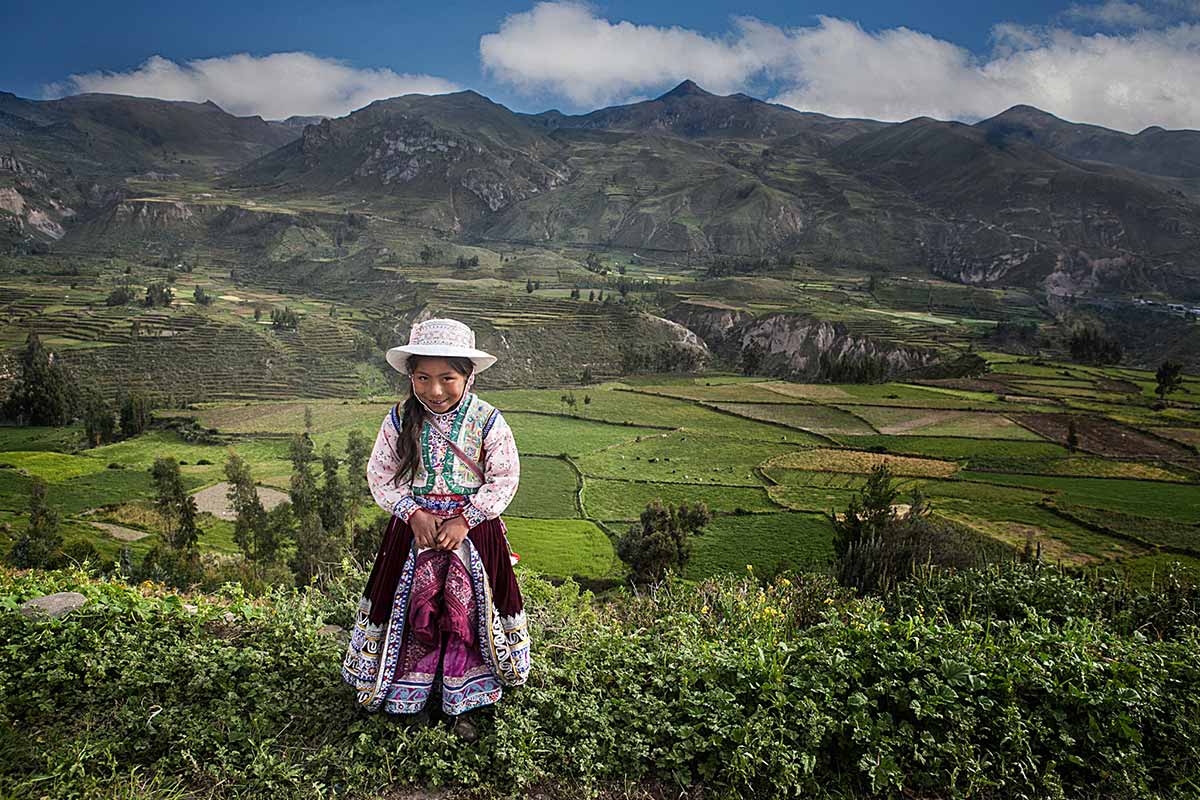
The modern residents of Colca Canyon are inheritors of a long history and deeply-rooted traditions. Original photo by Peru For Less.
Around 600 AD, the Collaguas and Cabanas flourished in Colca. The groups developed agricultural technology such as terraces on the sides of mountains to create land for farming, which in turn led to denser settlements. They also built colcas, stone reservoirs placed at higher elevations, to store grains and tubers in cold and dry conditions – nature’s icebox. These dual developments enabled populations to avoid famine in times of difficulty and became instruments to amass political power.
Over the next three centuries, the Wari civilization spread its influence into the southern Andes and introduced new agricultural technology. Multiple administrative and ritual centers were established to oversee the further centralization of political power. Post-Wari political power appears to have become dispersed again, but the agricultural economy remained intact. Collaguas and Cabanas regained their political independence and maintained relations of trade and exchange.
The arrival of the Incas around 1450 AD once again altered the political landscape. Incan elites intermarried with local rulers and thus gained access to the economic and agricultural realms of the Colca region.
Arequipa Tours:
The 100-mile (160-km) drive from Arequipa to the town of Chivay takes about three hours by car and longer by bus. Buses from Arequipa typically go to Chivay, but you’ll want to check in advance if service continues further into the canyon to Cabanconde.
While traveling from Arequipa to Colca, you pass through highland landscapes and the Salinas and Aguada Blanca National Reserve . Here, you can spot herds of elegant vicuñas by the side of the road, numerous volcanoes, and beautiful high altitude landscapes crossing Patapampa Pass.
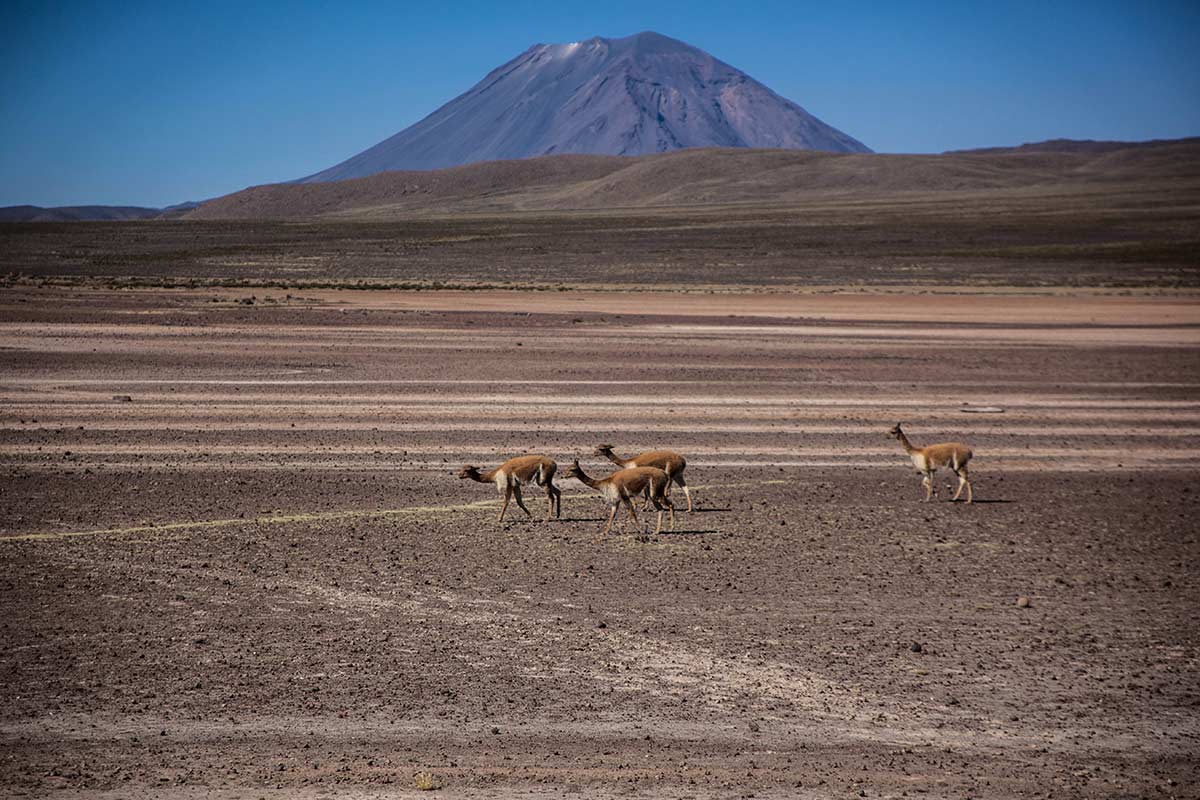
Vicunas roam free in the national reserve between Arequipa and Colca Canyon. Photo by Peru For Less.
Colca is the name of the canyon, river, and valley in the province of Caylloma 100 mi (160 km) northwest of Arequipa. The Colca region sits atop a major fault that fractured millions of years ago. Over millennia, the continuous flow of the Colca River has carved deep into the volcanic rock and formed Colca Canyon. Intense geothermal activity persists, as evidenced by the many geysers, fumaroles, and hot springs in the region.
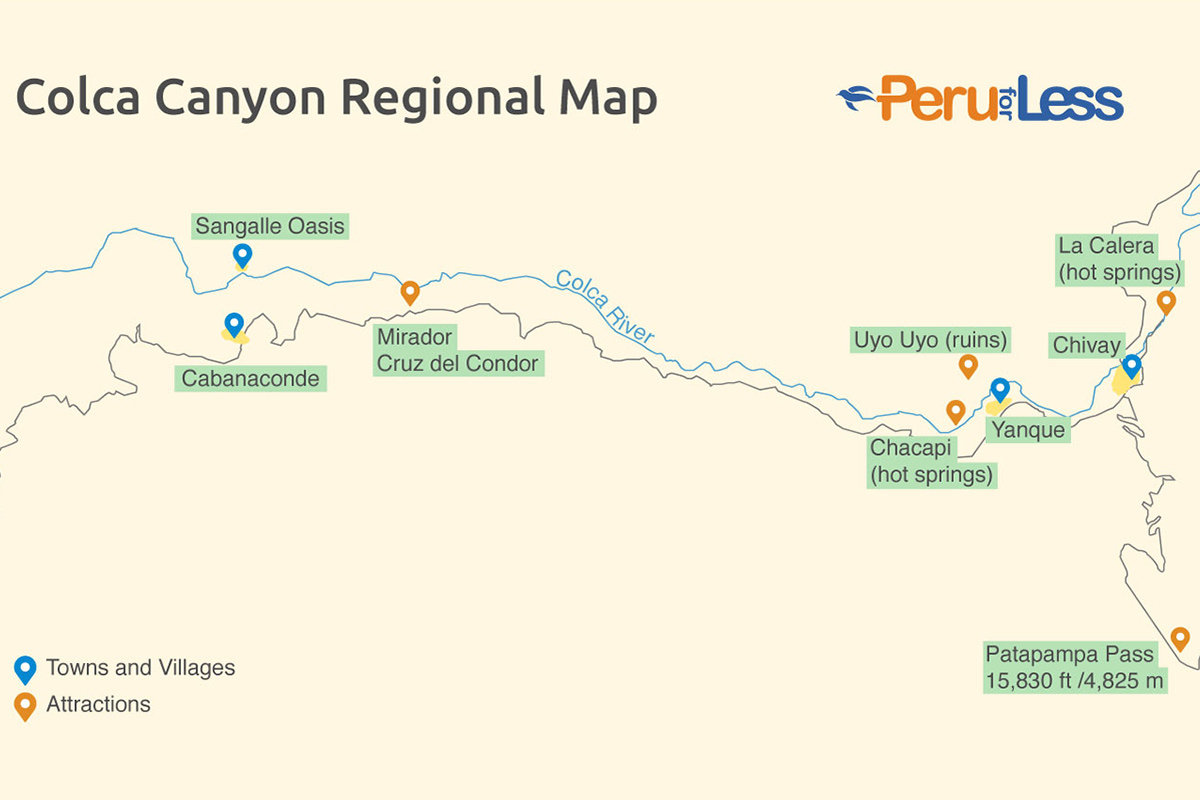
The town of Chivay is between the rim and the depths of the canyon. For its geographical location, Chivay has become a transit point for travelers venturing from Arequipa into the canyon, including those who arrange to spend the night at a hotel in Colca Canyon.
From Chivay, continue deeper into Colca to smaller towns like Yanque (5 mi/8 km away) and the famous lookout point for condors (26 mi/42 km away). The village of Cabanaconde, where many treks begin, is 34 mi (55 km) on the opposite side of the canyon from Chivay.
Elevations vary dramatically throughout the Colca region. Chivay (elevation 11,800 ft, or 3,600 m) is the midway point between the valley’s highest and lowest elevations. The road between Arequipa and Colca Canyon goes over the soaring 15,830-ft (4,825-m) Patapampa Pass before dropping down to Chivay and other destinations like Cabanaconde at 10,760 ft (3,280 m).
At its deepest point, Colca Canyon cuts roughly 13,648 ft (3,534 m) into the earth in the Huambo district in Peru’s Caylloma province. This depth makes Colca the world’s second deepest canyon. Nearby Cotahuasi Canyon is the 3rd deepest canyon in the world with a maximum depth of 11,595 ft (3,534 m). For reference, Grand Canyon in Arizona, United States is about 6,000 ft (1,830 m) at its deepest point.
Weather for Colca Canyon is typical of the Andes and high elevation destinations in Peru. The region experiences a rainy summer and a dry winter with transitional periods in between.
Temperatures vary with elevation. The lowest parts of the canyon can get quite warm in the dry season, especially on hiking trails exposed to direct sunlight. The higher you go, the colder and windier it gets. Mornings and evenings tend to be quite chilly, especially in the dry season.
A day tour is the easiest way to check out the highlights of Colca Canyon if your time in the region is limited. Many 1-day tours depart early from Arequipa and kick off with a stunning drive through the Salinas and Aguada Blanca National Reserve. After dropping into the valley and passing Chivay, continue to the famous “Cruz del Condor” viewpoint to hopefully see flying condors. Additional tour stops vary but often include time to enjoy lunch in Chivay before the return trip to Arequipa or the next destination.
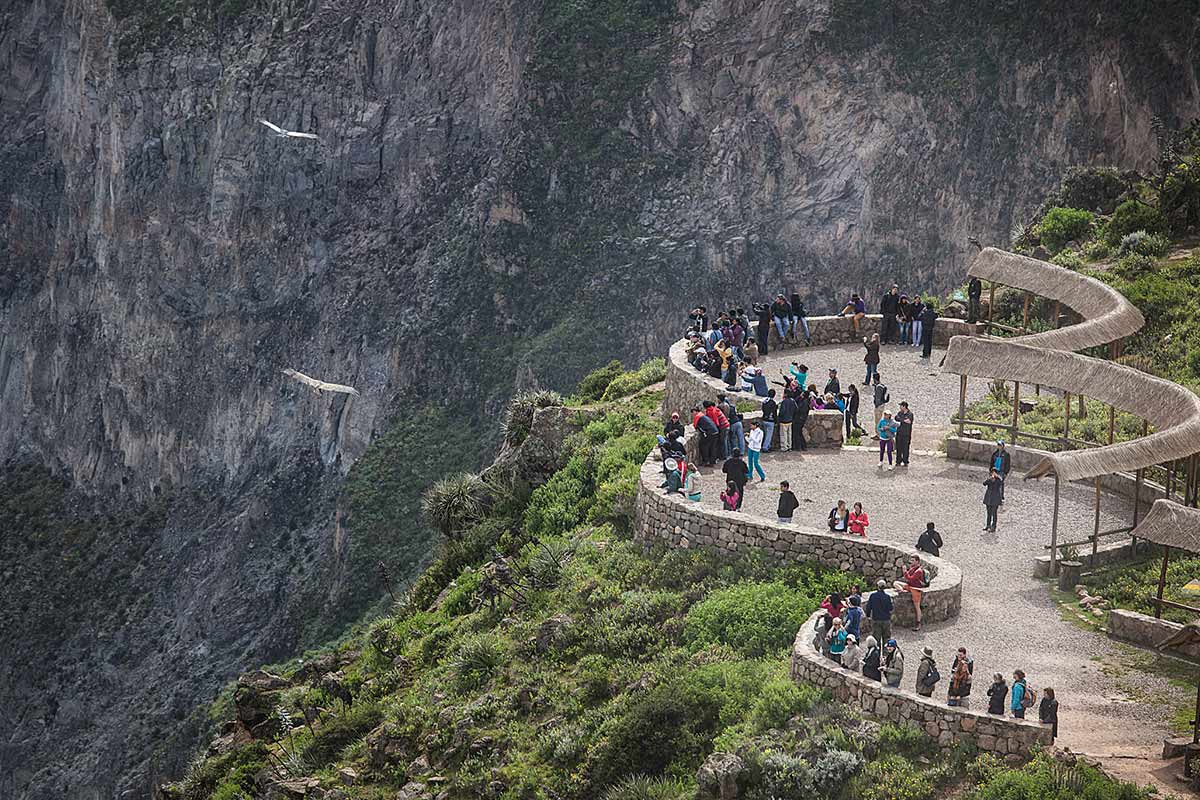
Mirador Cruz del Condor is the place to go for condor-spotting. Photo by Peru For Less.
Spending at least one night in Colca Canyon is a wonderful way to experience the region at a relaxed pace. Logistics of 2-day tours vary on where you’re coming from and where you want to stay. Commonly, tours depart from Arequipa and include an overnight stay at a hotel near Chivay or Yanque (unless you are planning on doing a hike).
Here’s a sample 2-day tour of Colca:
Departing from Arequipa, the journey to Colca Canyon begins with a drive northeast towards the volcanoes Chachani and Misti. After about two hours, stop at Pampa Cañahuas to observe wild vicuñas and then at Pata Wasi to enjoy a cup of traditional, altitude-relieving mate de coca. The final stop at Patapampa overlooks (4,820 meters) the surrounding altiplano region and volcanos.
More majestic views accompany you on the winding road down into Colca Canyon. Stop in town for lunch and then continue to your hotel have the rest of the day free. Set out on a walk through the countryside, take a dip in the natural hot springs, or do nothing but sit and relax.
Wake up early the next morning and head to Mirador Cruz del Condor. Continue exploring other canyon highlights or continue on to your next destination.
Colca is a top destination for trekking in Peru independently or with a group. Colca Canyon treks use the web of walking trails that connect towns in the valley. Depending on your schedule, you can choose from 2-day, 3-day, and 4-day treks. The longer you walk, the fewer people you’ll see sharing the trails. Read our trekking guide to Colca Canyon .
Colca trails tend to be unrelentingly steep. Travelers should take care to acclimate to the elevation before trekking, and those with knee or back problems are advised to stick closer to town and attempt gentler walks to hot springs, archaeological sites, and lookout points.
Contact our travel experts for advice on how to best customize your trip to Colca Canyon and other Peru destinations.
Colca Canyon is one of the best spots in South America for close-range observation of condors. Mirador Cruz del Condor is a viewing platform that encapsulates the magic of the high Andes. In front of you, the mountains rise to sky-scraping heights. Below you, the valley floor spills down to vertigo-inducing depths. And above you, Andean condors with 8-foot (2.5-meter) wingspans can be seen (with luck) soaring gracefully on the thermal drifts created in the canyon, drawing gasps from awed onlookers.
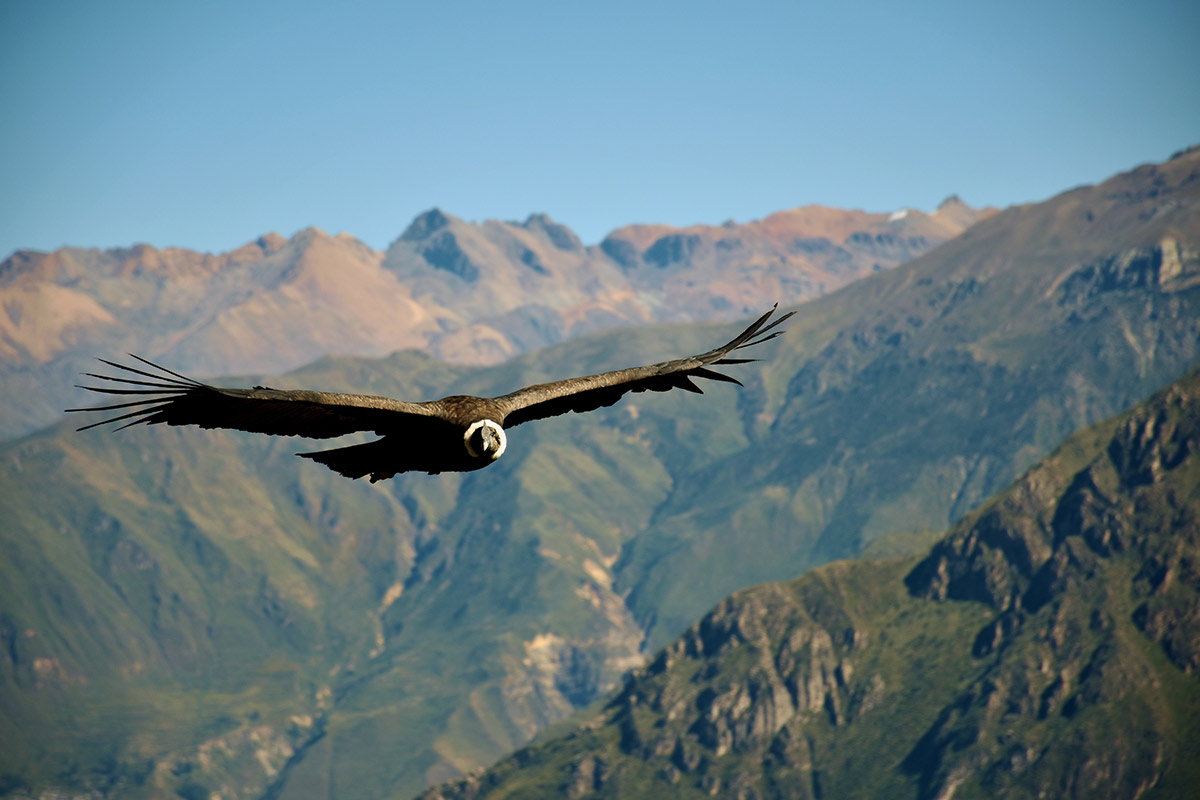
The best time to observe condors is in the morning hours in Colca Canyon. Photo by Jean Vella on Unsplash .
Condors play an important role in the folklore and mythology of the Andean regions throughout Latin America. Considered the animal of the spirit world according to the Inca, it is easy to understand why when you see the majestic creatures swooping through the air. Read more about condors in Peru .
Chivay is the tourism hub of Colca and sits on the banks of the Colca River at 11,800 ft (3,600 m). The town is the linking point between the two sides of Colca Canyon and is a watershed in the region’s environmental and ecological economy. Agriculture flourishes below this elevation, while livestock and ranching dominate the upper highland economies.
In Chivay, there are plenty of choices for lodging, a lively market hosted in the plaza, and shops selling high-quality local handicrafts. Just a short walk out of town are the hot springs of La Calera – perfect for a relaxing soak after a day of exploring.
The quaint town of Yanque boasts spectacular views over the river and surrounding volcanoes such as Sabancaya and Mismi (whose glacier is the source of the Amazon River). In the morning, the central plaza serves as a stage for local schoolchildren to perform folkloric dances for tourists.
Also on the plaza, Immaculate Conception Church is considered to be the most architecturally beautiful of the valley’s churches. First built in 1560, destroyed in an earthquake 100 years later, and rebuilt again in the late 17th century, the church displays a baroque mestizo style with a carved bas relief portal entrance.
On the road out of town, you’ll see a magnificent example of pre-Columbian terracing at Llaqta Cucho whose name means amphitheater.
Whether you’re spending the night in Chivay or have just completed a trek, consider relaxing in one of the numerous hot springs and geysers throughout Colca Canyon. Locals believe the pools have curative properties, especially for rheumatism and arthritis.
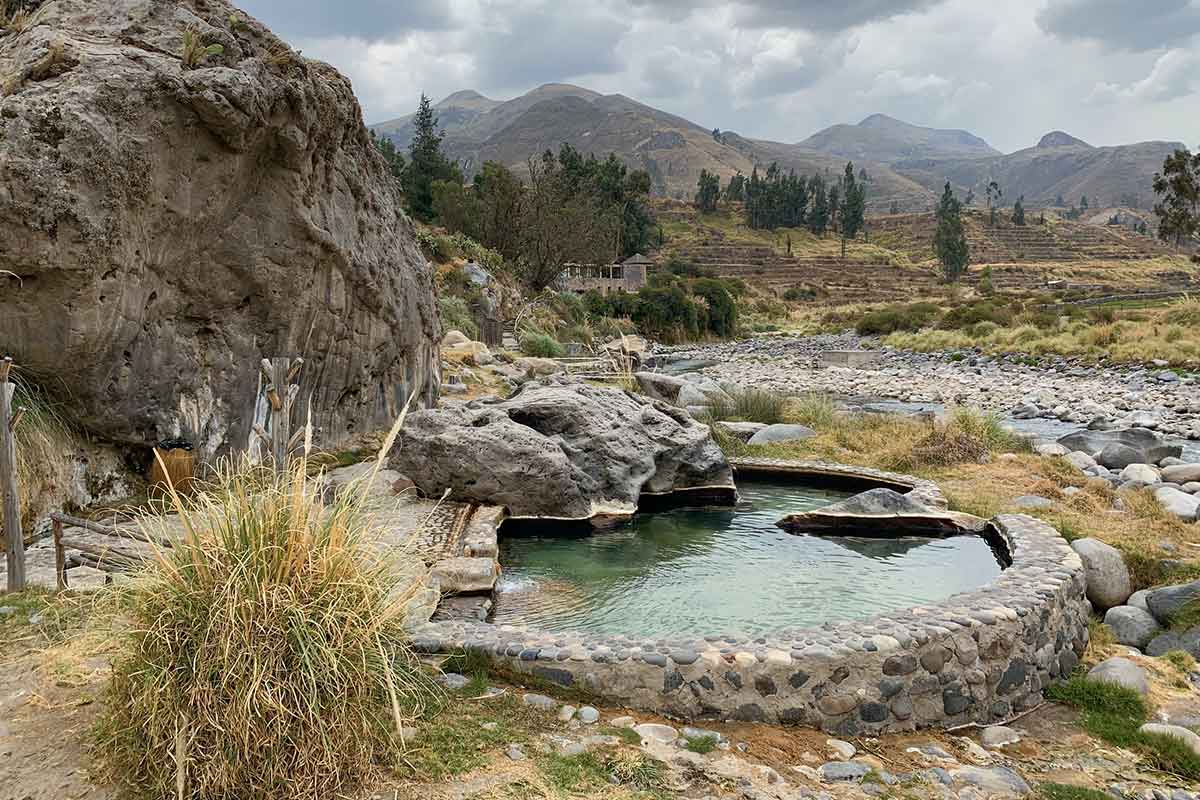
Enjoy the private hot springs as a guest of Colca Lodge. Photo by Agnieszka M on Unsplash .
Direct your eyes to the glittering nighttime sky over Colca Canyon. In Chivay, Casa Andina Standard has a small planetarium and observatory with nightly tours offered in English and Spanish. Clouds obstruct the constellations during the rainy season in Colca, so the planetarium is generally closed between January and March. Learn about Inca astronomy and the southern night sky.
Cabanaconde is the closest town to Mirador Cruz del Condor, and the starting point for Colca Canyon treks to Sangalle. The town is great for travelers in search of day hikes as there are outstanding lookout points within easy walking distance. From the trail viewpoints of Cejana, San Miguel, and Achachiwa, you can peer down at villages tucked into the valley bottom. The sight of hulking mountains across the canyon is truly humbling. You might even see a condor or two swooping past.
From Cabanaconde, it’s just a two- to three-hour walk down a zigzagging path to the small oasis town of Sangalle. Along the way, there are impressive views of the valley landscape. Down in Sangalle, a handful of lodges receive trekkers. Amenities are basic, but you’ll have all you need for a relaxing stay in this truly magnificent setting.
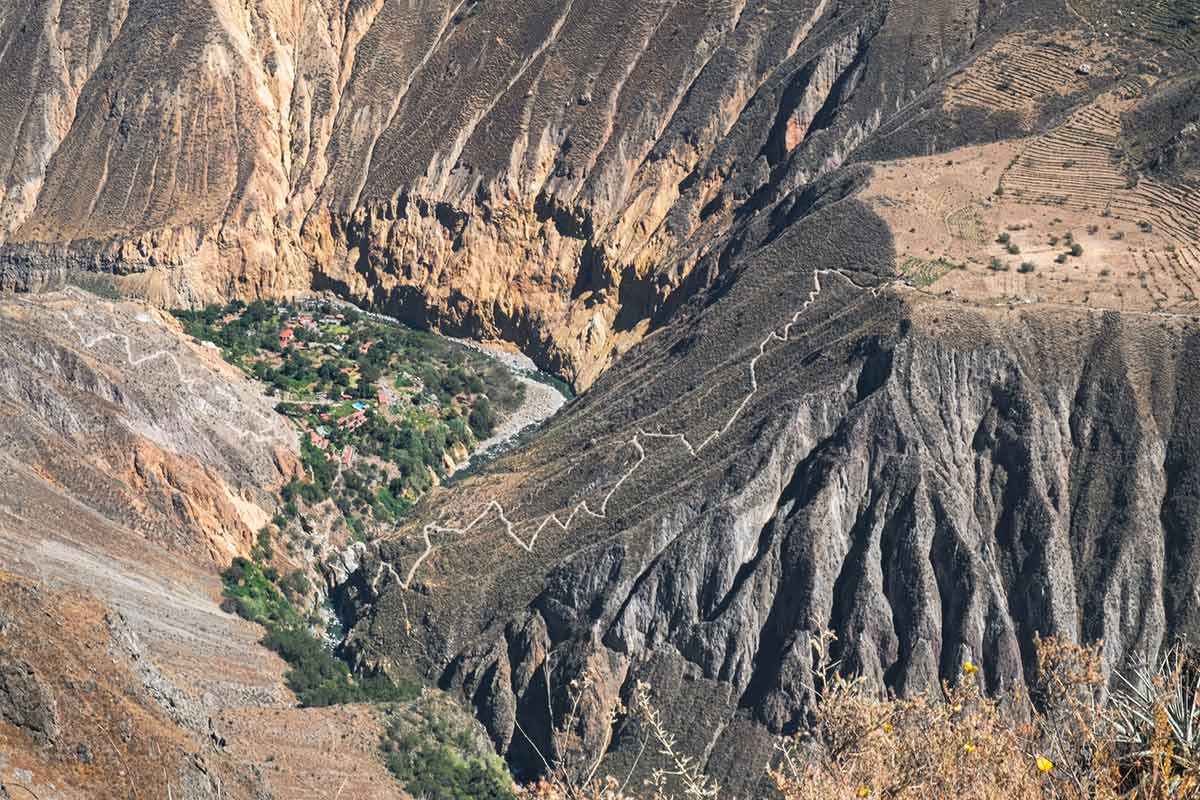
Escape to the canyon oasis of Sangalle. Photo by Sander Lenaerts on Unsplash .
If you’re staying in Yanque, make the short side trip to Uyo Uyo, a ruined pre-Inca village built of stone blocks held together with clay mortar. The site was first occupied by the Collagua group in the 1300s and later by the Inca civilization. The ruins you’ll see are the result of extensive restoration work over three years. You can undertake the two- to three- hour loop trail from town, finishing with a refreshing dip in the Chacapi hot springs.
Learn about Colca and its diverse communities on a visit to Museo de Yanque. Three exhibition rooms display scale models of colonial-era Colca churches, as well as ceramics, textiles, skulls, maps, paintings, and dioramas depicting pre-Columbian life. An additional room depicts contemporary life in the Colca Valley, from plants and animals to agriculture, religion, and typical dress. The museum also offers textile workshops and a program of cultural activities throughout the year.
Accommodations in Colca are close to Chivay, Yanque, and Cabanaconde. Enjoy a good night’s rest in the shadows of glacier-capped peaks and a tranquil day away from the crowds. Browse our preferred selection of Colca Canyon hotels , from the luxurious Aranwa Colca to budget-friendly options such as Casa Andina Colca and La Casa de Mami Yacchi.
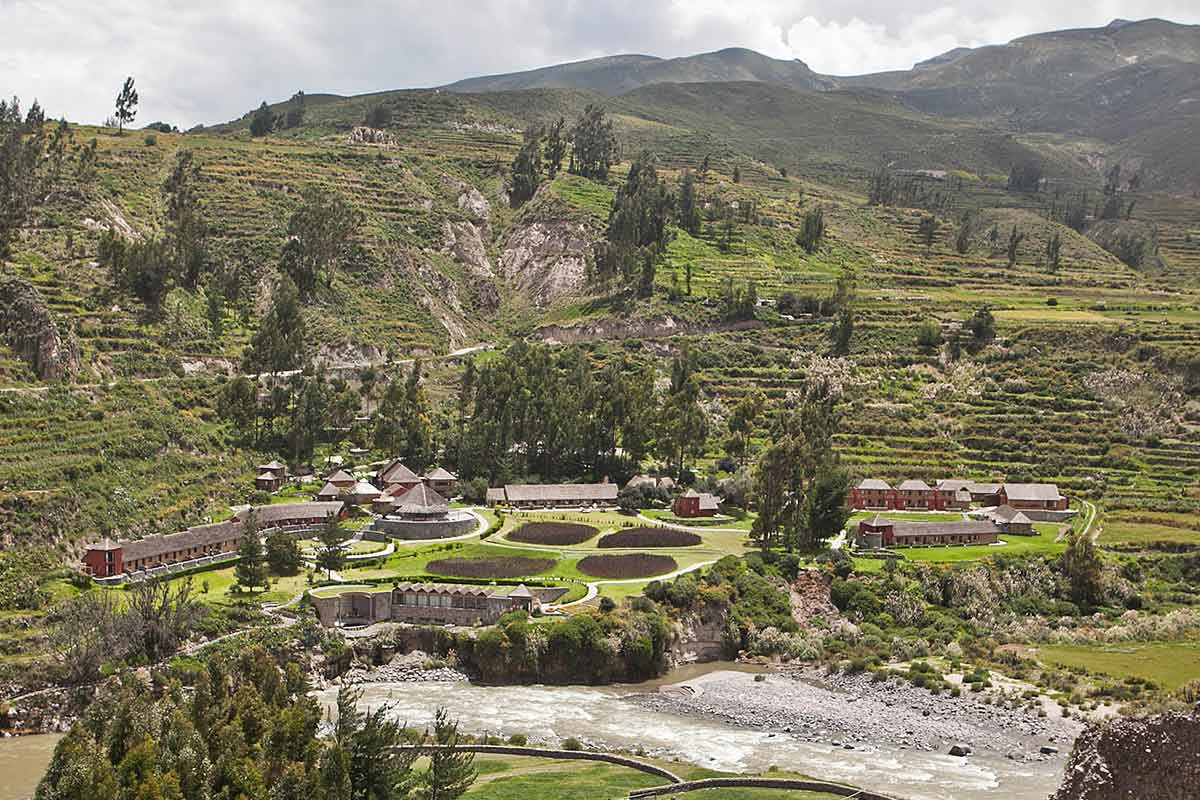
Colca Lodge, Colca Canyon, Peru. Original photo by Peru For Less.
Consider customizing your travel itinerary with an overnight stay at Colca Lodge near Chivay, home to arguably the most incredible hot springs in all of Peru. Guests have exclusive access to the lodge’s private thermal pools overlooking the river and can top off their rejuvenating afternoon with a massage at the on-site Spa Eco Thermal.
The best time to visit Colca Canyon is during the dry season from May to November. Trail conditions are pleasant, there are better chances of seeing condors in the region, and the weather is usually sunny. Weather varies considerably by region, so be sure to research the best time to visit Peru if you plan to visit other destinations.
Many towns of Colca Canyon are higher in elevation than Arequipa (7,660 ft, or 2,335 m). Colca is about the same elevation as Cusco (11,155 ft, or 3,400 m). Take the same precautions as you would in Cusco – stay hydrated, avoid heavy meals or alcohol on your first days at high elevation, and drink the local remedy coca leaf tea (mate de coca in Spanish).
All visitors to Colca Canyon must pay a 70 soles entrance fee. You can buy the ticket at any checkpoint. Hold on to the ticket because park officials will ask to see it at various checkpoints.
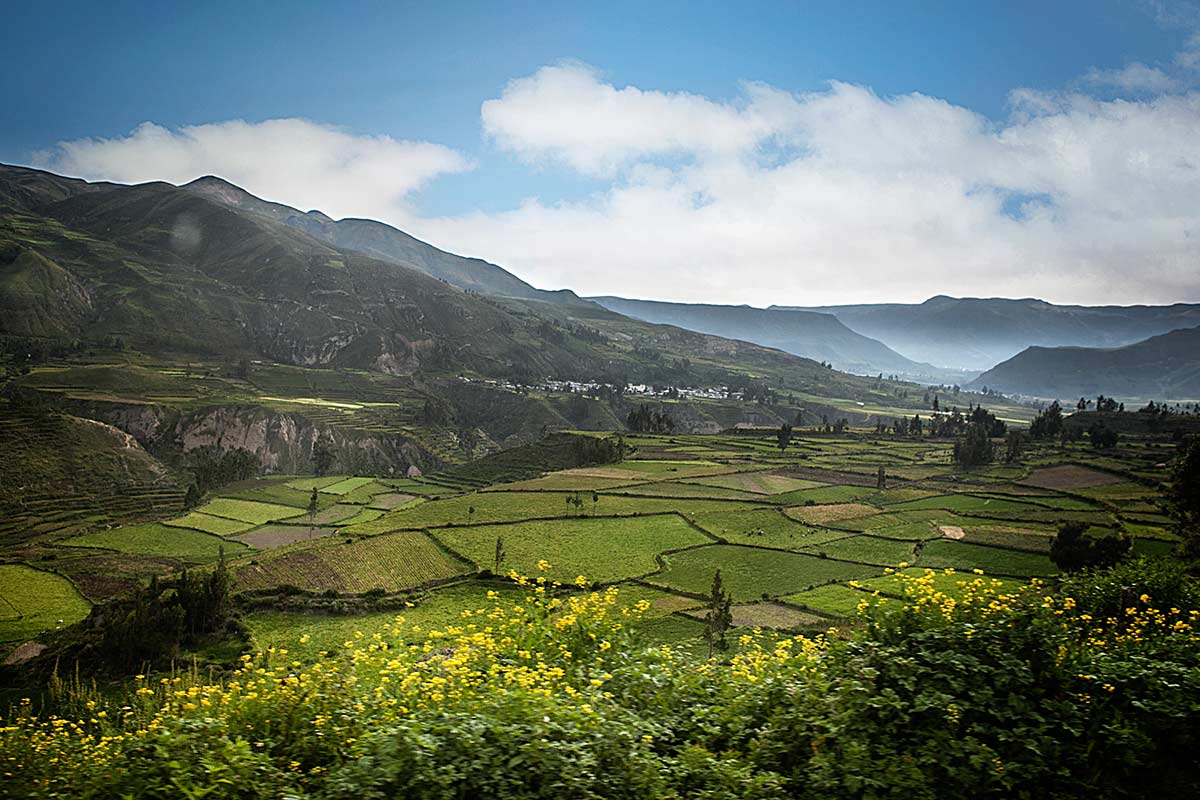
An adventure awaits in Colca Canyon. Original photo by Peru For Less.
Full-day tours of Colca Canyon depart from Arequipa. Alternatively, you can spend the night at a hotel to explore the region at a slower pace. Two days gives you more time to soak in the beautiful scenery and see flying condors.
Browse a variety of fully-customizable tour packages to Colca Canyon and other exciting destinations in Peru. Contact our team , and we’ll put you in direct contact with one of our experienced travel advisors who will craft an itinerary, just for you!



Email: [email protected]
Sign up to receive our newsletter for great articles, stunning photos, and special deals.